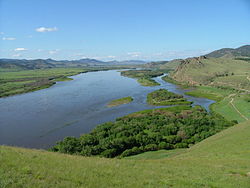
This is a list of notable rivers of Mongolia , arranged geographically by river basin.
Contents
- Longest rivers
- Flowing into the Arctic Ocean
- Flowing into the Sea of Okhotsk (Pacific Ocean)
- Flowing into endorheic basins
- Hulun Lake
- Ulaan Lake
- Great Lakes Depression
- Ulungur Lake
- External links
The Mongolian words for river are gol (гол) and mörön (мөрөн), with the latter usually used for larger rivers. The Mongolian names also occasionally have a genitive construction, with the name of the river having the suffix -iin (-ийн) or -yn (-ын). For example, the Ider River's Mongolian name is Ideriin gol (Идэрийн гол), equivalent to saying "the river of Ider".




